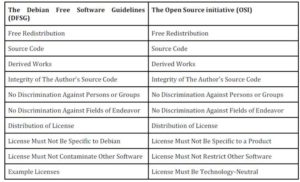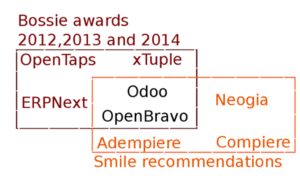Serrano and Sarriegi (2006) state that the benefits of applying FLOSS are greater for ERPs than for other kinds of applications, for three main reasons:
Increased adaptability. ERPs are not plug-and-play. They always need an implementation project to match the business processes and local regulations.
Having full access to the ERP source code can facilitate this unavoidable customization. Trade barriers, custom and technical regulations, tariff rates and import taxes, warranty and non-warranty repairs, export controls, labeling/marking standards, conformity assessment, product certification, and accreditation overview, in addition to membership in Free Trade Agreements with the Maghreb Arab Union, Saudi Arabia, Jordan, Tunisia, Egypt, USA and EU, are all elements of an equation that proves the fact that Moroccan Agribusiness SMEs are highly flexible and adaptable to change, and so must be their EIS.
Decreased reliance on a single supplier. Businesses that acquire a proprietary ERP are highly dependent on the product builders and distributors — that is, the source code’s owners. If one, or even both, of these agents disappears, upgrading and maintaining the ERP can pose significant problems.
An ERP system is a complex piece of software; therefore joining a promising and stable project is better than starting a new project from scratch in the bazaar style.
This advice is aligned with the traditional wisdom of reuse as well. (Boldyreff, 2005) Especially with FLOSS ERP, where its FLOSS nature and modular design also allows any qualified software developer to put together product offerings for specific industries and customize the software to be adaptable to the ever changing functional needs while not re-inventing the wheel by duplicating the more universal functions like inventory control and purchasing.
Customers benefit by not having to buy and maintain functionality that they don’t want or need. Specialized Institutes of Applied Technology (ISTA) that is present in most of Moroccan cities, Students bearers of general university studies diploma, and State/Private schools of engineering graduates, are all potential system integrators or at least qualified software developers for the Moroccan local market, that can help decrease the reliance on a single supplier.
Reduced costs. Proprietary ERP licenses are expensive. A rule of thumb puts them at between one-sixth and one-third of the implementation project costs. OSS ERPs avoid this cost. Furthermore, they usually do not need expensive hardware to run.
Although Open Source systems do not have licenses costs, the probable budget is spent with IT staff and/or consultants (Gripe, F.G.S and Rodello, I.A., 2012). Besides, Boldyreff (2005) states that the ever-falling price of hardware has also contributed to the popularity of OSS. Unlike in the past, nowadays the cost of software applications could easily surpass that of the hardware components in a system.
This reversal has forced suppliers and customers to rethink the conventional software licensing models used in business The SME, unit of study, expresses that the use of a web based ERP system is more important than it being FLOSS or proprietary, because of the costs of ERP software clients to be reinstalled each time viruses, and other sorts of malwares slow down the PCs on which the software clients are installed.
In Morocco, reformatting and reinstalling a PC with an Operating System and Software utilities costs no more than 200 Moroccan dirhams, but re-installing the ERP software client can vary from 500 dh to 2000 dh, which will make the ERP system’s total cost of ownership not affordable for SMEs, especially, when there are tens of system’s users.
Once the ERP system selected, implemented and being used by the SME, the following was observed:
The ERP system appropriation rate can tumble down, once it comes to bills, taxes and margins, if the system does not give the SME the needed Adaptability and Flexibility.
Study Limitations
The period of time “5 months” is enough for every aspect to be raised, except for aspects related to the evolvement and evolution of the SME’s activity. So we can study the potential of the ERP system modularity.
Besides the very well renowned web-based source code repository “SourceForge”, new source code repositories that host FLOSS projects in general have emerged, like Github and Bitbucket, and have gained in popularity among FLOSS developers and contributors, we will try to establish a clear and concise comparison of the different FLOSS ERP systems no matter where they are hosted.
The SME, unit of our exploratory study, neither benefited from the “Imtiaz” nor the “Moussanada” programs launched by Morocco’s National Agency for the Promotion of SMEs. It would be helpful to compare between the cases where an SME is eligible and takes advantage of one or both programs, with the actual case that does not benefit from any of them both.
Conclusion
Ultimately, Boldyreff (2005) mentioned that looking at the number of reported research on Open Source ERP published in Scientific and Academic journals and proceedings, compared to the numerous articles that have been published in non-academic industrial trade magazines, implies that currently there is a gap between the market demand and the research carried out by academics.
In this paper, we have found that FLOSS ERP systems adoption is not of an issue for Moroccan SMEs, unless it is not a web based ERP system, for it being used on-line through Internet, as a Cloud solution or only accessible from a local area network; we have proposed a selection framework depending essentially on two factors, the software factor and the business partner factor. Furthermore, a FLOSS ERP system, despite taking advantage of the four freedoms of a FLOSS license, sees its appropriation rate tumbles down, depending on the flexibility and adaptability that the system offers concerning bills, taxes and margins.
In terms of managerial implications, the findings presented are of interest for both SMEs that want to adopt a FLOSS ERP system and look for a successful ERP implementation and for IT providers and integrators that target Moroccan SMEs’ Information Systems; it is shown that there are cultural and organizational reasons other than the costs involved when deciding on which ERP system to choose.
References
1. Alshawi, S., Themistocleous, M.andAlmadani, R., (2004), ‘Integrating Diverse ERP Systems: a Case Study’, The Journal of Enterprise Information Management, Vol. 17, No. 6, 2004, pp.454-462.
Published-google scholar
2. Aversano, L., Pennino, I. and Tortorella, M., (2011), ‘Evaluating the quality of free/open source ERP systems’, 12th International Conference, ICEIS 2010, Funchal-Madeira, Portugal, June 8-12, 2011, vol.73, pp.119-134
3. Baratashvili, T and Machtidze, T. (2014), ‘Open source ERP — new opportunities for Georgian small and medium enterprises’, Ilia State University, Tbilisi
4. Boldyreff, C and Kim, H., (2005) ‘Open source ERP for SMEs’. ICMR 2005, 6-8 Sept 2005, Cranfield University, U.K..
5. Johansson, B and Sudzina, F, (2009) ‘Choosing open source ERP systems: what reasons are there for doing so?’, Open Source Ecosystems : Diverse Communities Interacting, 143-155.
Published – google scholar
6. Debian Social Contract [online]. Available from: https://www.debian.org/social_contract#guidelines . [Accessed 20 March 2015].
7. FLOSS and FOSS [online]. Available from: http://www.gnu.org/philosophy/floss-and-foss.html. [Accessed 20 March 2015].
8. Fougatsaro, V. G. (2009), ‘A study of open source ERP systems’, School of Management, Blekinge Institute of technology, Blekinge.
9. Free Software, Open Source, FOSS, FLOSS — Same same but different [online]. Available from:http://blog.schiessle.org/tag/community/.[Accessed 20 March 2015].
10. Gorishti, A. and Sevrani K. (2012), ‘A survey on open source ERP and the reasons for their use by SMEs’, International Journal of Science, Innovation & New Technology, July 2012, p1.
11. Gripe, F.G.S and Rodello, I.A. (2012), ‘A brief survey of open source ERP systems usage on Brazilian organizations’, Proceedings of IADIS International Conference Information Systems 2012, Berlin.
12. Interview: Richard M. Stallman [online]. Available from: http://www.gnu.org/philosophy/luispo-rms-interview.html . [Accessed 20 March 2015].
13. Johansson, B and de Carvalho, R.A. (2010), ‘Enterprise resource planning systems for small and medium — sized enterprises’, Handbook of Research on Software Engineering and Productivity Technologies: Implications of Globalisation p.373-381 Engineering Science Reference
14. Johansson, B and Sudzina, F., (2008), ‘ERP systems and open source : an initial review and some implications for SMEs’, Journal of Enterprise Information Management, vol. 21 no. 6, 2008, pp.649-658.
Published – google scholar
15. Lengnick-Hall, C.A., Lengnick-Hall, M.L. and Abdinnour-Helm, S. (2004), “The role of social and
intellectual capital in achieving competitive advantage through enterprise resource planning
(ERP) systems”, Journal of Engineering & Technology Management, Vol. 21 No. 4, pp. 307-
30.
Published – google scholar
16. Lord Kelvin, (May 3rd, 1883), ‘Lecture on “Electrical Units of Measurement”.’ Popular Lectures, Vol. 1, page 73.
17. Makhroute, M., Morsli, A., Tawafi I. and Rholam Y., (2013), ‘The Issue of the Definition of Moroccan SMEs and Different Approaches’, Journal of US-China Public Administration, ISSN 1548-6591 May 2013, Vol. 10, No. 5, pp. 488-496.
18. Ministry of Agriculture and Maritime Fisheries (2012) ‘The Moroccan Agriculture in numbers 2012’, Kingdom of Morocco.
19. Ministry of Finance and Privatization (August 2003), ‘Evaluation of SME financing in Morocco’, Kingdom of Morocco.
20. Morocco. (2002). Charter for Small and medium sized Enterprise, Law No. 53-00, Article No. 1.
21. Mushtaq Ali Shah, S and Huq, N. (2010), ‘Why selecting an open source ERP over proprietary erp? a focus on SMEs and suppliers perspective’, Jonkoping university.
22. Olson, D.L., Staley, J. (2010), ’Case study of open source ERP evaluation in a small business’, University of Nebraska, Lincoln, NE 68588-0491.
23. Rolland, C. and Prakash, N. (2000), “Bridging the gap between organisational needs and ERP
functionality”, Requirements Engineering, Vol. 5 No. 3, pp. 180-93.
Published – google scholar
24. Serrano, N.S. and Sarriegi, J.M. (2006), ‘Open source software ERPs : a new alternative for an old need’, IEEE Software, Vol.23, No.3, pp.94-97.
Published – google scholar
25. Stefanou, C. J. (2012). SMEs and FOS-ERP systems: Risks and opportunities. In R. A. Carvalho& B. Johansson (Eds.), Free and open source enterprise resource planning- systems and strategy (pp. 134—143). USA: Business Science Reference, IGI Global.
26. Stefanou , C. J. (2013), ’Adoption of Free/Open Source ERP Software by SMEs’, Information Systems for Small and medium-sized Enterprises Progress in IS, 2014, pp.157-166.
27. The Open Source Definition [online]. Available from: http://opensource.org/osd. [Accessed 20 March 2015].
28. What is free software? [online]. Available from: https://fsfe.org/about/basics/freesoftware. [Accessed 20 March 2015].
29. What is free software? [online]. Available from: https://gnu.org/philosophy/free-sw.html. [Accessed 20 March 2015].
30. Why Open Source misses the point of Free Software [online]. Available from: http://www.gnu.org/philosophy/open-source-misses-the-point.html. [Accessed 20 March 2015].
31. Wier, B., Hunton, J., &HassabElnaby, H.R. (2007).Enterprise resource planning systems and nonfinancial performance incentives.The joint impact on corporate performance.International Journal of Account.Inf. Systems 8, 165—190.
Published – google scholar










